Book contents
- The Cambridge Handbook of Areal Linguistics
- Cambridge Handbooks in Language and Linguistics
- The Cambridge Handbook of Areal Linguistics
- Copyright page
- Contents
- Figures
- Maps
- Tables
- Contributors
- Preface
- 1 Areas, Areal Features and Areality
- Part I Issues in Areal Linguistics
- 2 Why is it so Hard to Define a Linguistic Area?
- 3 Areas and Universals
- 4 Reassessing Sprachbunds: A View from the Balkans
- 5 Areal Sound Patterns: From Perceptual Magnets to Stone Soup
- 6 Convergence and Divergence in the Phonology of the Languages of Europe
- 7 Word Prominence and Areal Linguistics
- 8 Semantic Patterns from an Areal Perspective
- Part II Case Studies for Areal Linguistics
- Index
- References
7 - Word Prominence and Areal Linguistics
from Part I - Issues in Areal Linguistics
Published online by Cambridge University Press: 11 May 2017
- The Cambridge Handbook of Areal Linguistics
- Cambridge Handbooks in Language and Linguistics
- The Cambridge Handbook of Areal Linguistics
- Copyright page
- Contents
- Figures
- Maps
- Tables
- Contributors
- Preface
- 1 Areas, Areal Features and Areality
- Part I Issues in Areal Linguistics
- 2 Why is it so Hard to Define a Linguistic Area?
- 3 Areas and Universals
- 4 Reassessing Sprachbunds: A View from the Balkans
- 5 Areal Sound Patterns: From Perceptual Magnets to Stone Soup
- 6 Convergence and Divergence in the Phonology of the Languages of Europe
- 7 Word Prominence and Areal Linguistics
- 8 Semantic Patterns from an Areal Perspective
- Part II Case Studies for Areal Linguistics
- Index
- References
- Type
- Chapter
- Information
- The Cambridge Handbook of Areal Linguistics , pp. 161 - 203Publisher: Cambridge University PressPrint publication year: 2017

